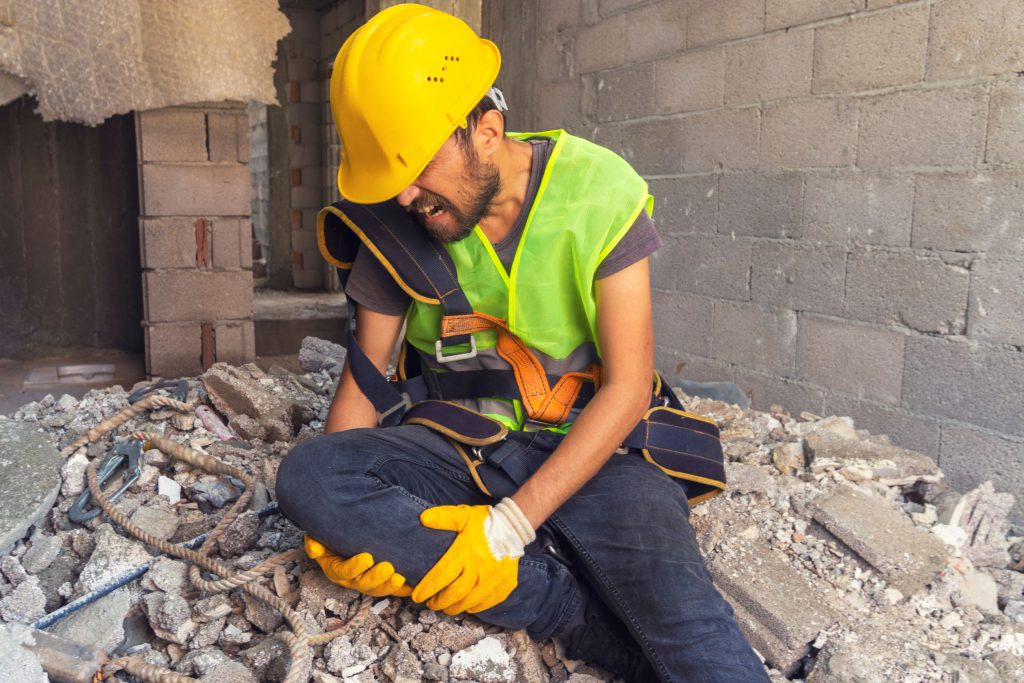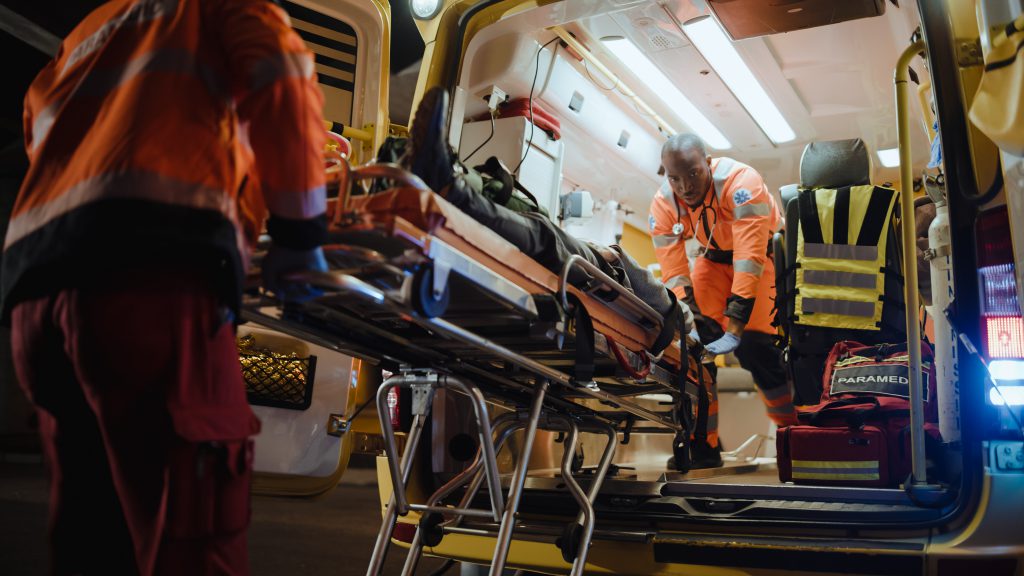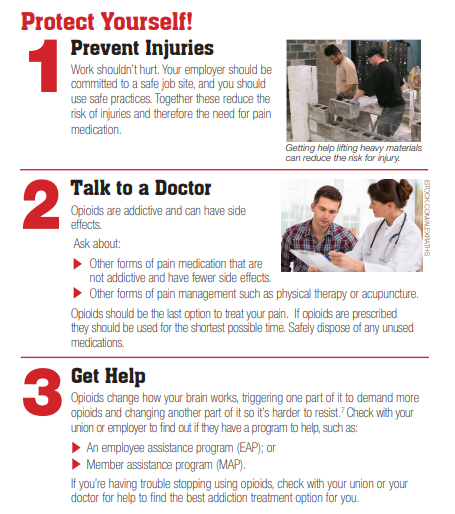Addressing the Opioid Overdose Epidemic in Construction: Minimize Work Factors that Cause Injury and Pain
Posted on by


Photos © Getty Images
Over 250 lives were lost to drugs every day in the United States in 2020.[1] A study published in July 2021 reported that during the COVID pandemic the U.S. has seen some of the deadliest months on record for the opioid overdose epidemic.[2] The drastic acceleration of the U.S. overdose crisis during the COVID pandemic calls for an increased dedication to all prevention efforts. [3]
Construction workers have been shown in many studies to have high rates of death from overdose compared to workers in other occupations. For example, a study in 2018 showed that, among all occupations, construction workers had the highest rate of death from overdose, including overdose from heroin.[4] Data from 2011-2016 showed that construction workers experienced 15% of all workplace overdose deaths[5] (despite representing about 7% of the workforce).[6] That same study showed that the construction industry has the third-highest rate of workplace overdose fatalities from all substances among industries in the U.S.[5]
Rates for prescribing opioid use among workers are based on many factors,[7] including the industry in which the worker is employed. In a recent study of workers compensation data from 27 states, mining and construction workers were more likely than workers in other industries to receive opioids when receiving a prescription for pain medication.[7] The size of the workplace can also be a factor for prescribing opioids. Workers in very small companies* are prescribed opioids more frequently than workers in larger ones [7] and about 90% of construction companies have fewer than 20 employees.[8]
Researchers have identified high rates of injuries in construction as a driver for the high prevalence of opioid use disorder among workers in the industry.[9-12] The construction workforce has the highest rate of injuries compared to other occupational groups.[13,14] For perspective, about one-third of construction workers have at least one musculoskeletal disorder (MSD) and opioid prescription use is three times higher among construction workers with MSDs than those without an MSD.[15] Additionally, workers with broken bones, neurologic conditions in the arms (such as carpal tunnel syndrome), and neurologic spinal pain are most likely to receive an opioid when getting a prescription for pain medicine.[7] Age can also play a factor. Younger workers are more likely to use illicit drugs whereas older workers are more likely to use prescribed opioids. [16]
Risks for Developing Opioid Use Disorder in Construction
A recent study from Washington University in St. Louis investigated health care among more than 19,000 union construction workers from January 2015 to June 2018 and measured the risk of developing opioid use disorder.[17] The researchers found that construction workers prescribed opioids for musculoskeletal pain had a higher risk for long‐term opioid use and for developing opioid use disorder. Annually, 15% of workers who were prescribed opioids became long‐term users. They also found that long-term users were nearly 10 times as likely to develop opioid use disorder.
The study revealed that of those eligible for healthcare services, 40% received care for chronic MSDs and approximately one-quarter of those receiving care for chronic MSDs were prescribed opioids within three days of their diagnosis. Of those prescribed opioids, about 1 in 15 received long‐term opioid prescriptions. Construction workers who received opioids for diagnoses other than MSDs, such as kidney stones, stomach pain, and dental visits, were not found to have an increased risk of long-term use and opioid dependency.
The study reported the following conditions increase construction workers’ risk of developing opioid use disorder:
- 2 times more likely if prescribed high doses (≥50 morphine milligram equivalents (MME)[†]/day).
- 4 times more likely if diagnosed with chronic MSDs.
- 7 times more likely if prescribed more than 7 days of supply.
- 10 times more likely if given long‐term opioid prescriptions[‡].
The findings support the need to improve working conditions and job design to reduce MSDs among construction workers, seek non-opioid alternatives to controlling pain, and change prescribing practices to reduce the risk for OUD and other opioid-related harms.
Health Equity Concerns
Many factors can make some workers more vulnerable than others to workplace illness or injury. These factors include age, race, class, sex, use of temporary workforce, and organizational factors, such as the size of the business.[18]

Hispanic persons make up a vulnerable population in the construction industry. Hispanic construction workers experience high rates of occupational injury, likely influenced by individual, organizational, and social factors. For example, even though Hispanic workers are only 29% of the construction workforce, they account for 39% of fatal falls to a lower level.[19] Several factors may contribute to this disparity, including language barriers and discriminatory practices that create hazardous work environments for Hispanic workers.[20]
Drug overdose rates among Hispanic persons have risen substantially in recent years. From 2014-2017, drug overdose death rates involving synthetic opioids increased by 617% for Hispanic persons.[21]
What Construction Employers Can Do
- Identify work factors that pose a risk of injury and take action to eliminate or minimize them.
- Ensure workers have access to health benefits that cover comprehensive injury care, physical therapy, mental health and substance use treatment.
- Provide paid time off when a worker gets injured on the job.
- Share information with employees on how to avoid opioid misuse and speak to medical providers about alternative pain treatments.
- Provide a work environment where workers feel safe talking about mental health and substance use without fear of stigma or repercussions, such as job loss.
- Provide support and educational materials to workers in a language they will understand using culturally appropriate information.
- For large companies, establish employee assistance and peer support programs.
- For small companies, work with trusted community-based organizations and leaders to get workers the help and support they need.
Continued efforts to prevent injuries and expand opportunity for and education concerning alternative pain management, as components of an overall prevention plan, will be critical to reduce the impact of the opioid overdose epidemic among construction workers.
Ann Marie Dale, PhD; Brad Evanoff, MD; and Brian Gage, MD; are with the Division of General Medical Sciences, Washington University School of Medicine, St. Louis, Missouri.
Douglas Trout, MD, MHS; J’ette Novakovich, PhD, MS, MA; Scott Earnest, PhD, PE, CSP; CDR Elizabeth Garza, MPH, CPH; and L. Casey Chosewood, MD, MPH; are with the National Institute for Occupational Safety and Health.
Construction Resources
- Opioids in the Construction Industry- Part 1: The Evolution of a Crisis — video
- Opioids in Construction- Part 2 Impacting Lives — video
- Opioids in Construction- Part 3 Pathways to Recovery —video
- Opioid Deaths in Construction Hazard Alert, also available in Spanish
- Opioid Deaths in Construction Toolbox Talk, also available in Spanish
- Opioid Awareness Training Program
- Physicians’ Alert – Pain Management for Construction Workers
- Protect Yourself from an Opioid Overdose Infographic also available in Spanish
- Peer Advocacy for Construction Workers Struggling with Substance Use and Mental Health
- Opioid Hazards & Awareness Resources— video
- Musculoskeletal Disorders and Prescription Opioid Use among U.S. Construction Workers— CPWR
- Prescription opioid use and associated factors among US construction workers— CPWR
- Overdose Fatalities at Worksites and Opioid Use in the Construction Industry—CPWR
Find Treatment
Other Resources
- NIOSH: Opioids in the Workplace
- Preventing Opioid Overdose Deaths in the Workplace
- Addressing Opioid Overdose Deaths in the Workplace — video
- Medication-Assisted Treatment for Opioid Use Disorder
- Drug Overdose in the Workplace and the Role of Opioids
- The COVID-19 Pandemic and the Opioid Overdose Epidemic: A Perfect Storm for Workers?
- Prescription Opioid and Benzodiazepine Medications and Occupational Safety and Health
References
1.CDC’s Vital Statistics. Products – Vital Statistics Rapid Release – Provisional Drug Overdose Data (cdc.gov). June 9, 2021
2.Friedman J, Akre S (2021). COVID-19 and the Drug Overdose Crisis: Uncovering the Deadliest Months in the United States, January‒July 2020. Am J of Pub Health. 111:1284-1291. https://doi.org/10.2105/AJPH.2021.306256
3. CDC Health Alert Network (2020). Increase in Fatal Drug Overdoses Across the United States Driven by Synthetic Opioids Before and During the COVID-19 Pandemic. CDCHAN-00438. https://emergency.cdc.gov/han/2020/han00438.asp
4.Harduar Morano L, Steege AL, and Luckhaupt SE (2018). Occupational patterns in unintentional and undetermined drug-involved and opioid-involved overdose deaths—United States, 2007–2012. MMWR Morb Mortal Wkly Rep; 67: 925–930.
5.Tiesman, H.M., Konda, S., Cimineri, L., et al (2019). Drug overdose deaths at work, 2011–2016 Injury Prevention 2019; 25:577-580. http://dx.doi.org/10.1136/injuryprev-2018-043104external icon
6. CPWR. Chart Book (6th edition): Labor Force Characteristics – Labor Force Structure and Definitions. https://www.cpwr.com/research/data-center/the-construction-chart-book/chart-book-6th-edition-labor-force-characteristics-labor-force-structure-and-definitions/
7.Thumala V, Wang D, Liu T-C (2018). WCRI Correlates of Opioids Dispensing. Cambridge, MA: Workers’ Compensation Research Institute, December, WC-18-48.
8. Dong XS, et al (2018). Fatal Injuries among Small Construction Establishments. https://www.cpwr.com/wp-content/uploads/publications/publications_Quarter3-QDR-2018_0.pdf .
9. Shaw WS, Roelofs C, Punnett L (2020). Work environment factors and prevention of opioid-related deaths. Am J Public Health 110:1235–1241. doi:10.2105/AJPH.2020.305716
10.Thumula V and Liu T-C (2018). Correlates of opioid dispensing. WC-18-48. Cambridge, MA: Workers Compensation Research Institute, https://www.wcrinet.org/reports/correlates-of-opioid-dispensing (accessed 11 January 2019).
11.Choi B (2020). Opioid use disorder, job strain, and high physical job demands in US workers. Int Arch Occup Environ Health; 9: 577–588.
12. Roelofs et al (2018). CPWR – The Center for Construction Research and Training. Construction chart book: fatal and nonfatal injuries, back injuries in construction and other industries. 6th ed. Silver Spring, MD: Author, 2018, https://www.cpwr. com/research/data-center/the-construction-chart-book/ (accessed 25 March 2021).
13. CPWR – The Center for Construction Research and Training (2017). Construction chart book: fatal and nonfatal injuries, back injuries in construction and other industries. Silver Spring, MD: Author, 2017, https://www.cpwr.com/sites/ default/files/publications/CB%20page%2048.pdf
14.Tiesman HM, Konda S, Cimineri L, et al (2019). Drug overdose deaths at work, 2011–2016 Injury Prevention; 25:577-580. http://dx.doi.org/10.1136/injuryprev-2018-043104
15. Dong XS, Brooks RD, Brown S (2020). Musculoskeletal Disorders and Prescription Opioids Use Among U.S. Construction Workers. J Occup Environ Med; 62(11);973-979. doi: 10.1097/JOM.0000000000002017
16. Dong XS, Brooks RD, Cain CT (2019). Overdose Fatalities at Worksites and Opioid Use in the Construction Industry. CPWR Quarterly Data Report: Fourth Quarter. https://www.cpwr.com/wp-content/uploads/2020/06/Quarter4-QDR-2019.pdf
17. Dale, AM, Buckner-Petty, S, Evanoff, BA, Gage, BF (2021). Predictors of long-term opioid use and opioid use disorder among construction worker: Analysis of claims data. Am J Ind Med; 64:48–57. https://doi.org/10.1002/ajim.23202
18. Hornback D, Cunningham T, Guerin R (2015). Overlapping Vulnerabilities. Washington DC: National Institute for Occupational Safety and Health, CDC. https://blogs.cdc.gov/niosh-science-blog/2015/08/28/overlapping-vulnerabilities/
19. NIOSH (2019). Construction Falls Campaign Infographic: Stop Fatal Falls. Washington DC: National Institute for Occupational Safety and Health, CDC. https://www.cdc.gov/niosh/construction/images/stopfallsinfographics/FY19ConstFatalFallsSnap-sm.jpg
20. Roelofs C, Sprague-Martinez L, Brunette M et al (2011). A qualitative investigation of Hispanic construction worker perspectives on factors impacting worksite safety and risk. Environ Health 10:84. https://doi.org/10.1186/1476-069X-10-84
21. SAMHSA (2020). The opioid crisis and the hispanic/latino population: an urgent issue.
[*] “Very small companies” defined as having a payroll of $ 1 to 4 million.
[†] Morphine milligram equivalents (MME) is a unit of measure used to compare opioids of varying potencies.
[‡] “Long-term” is defined as 60 days supply or more per calendar quarter.
Posted on by

